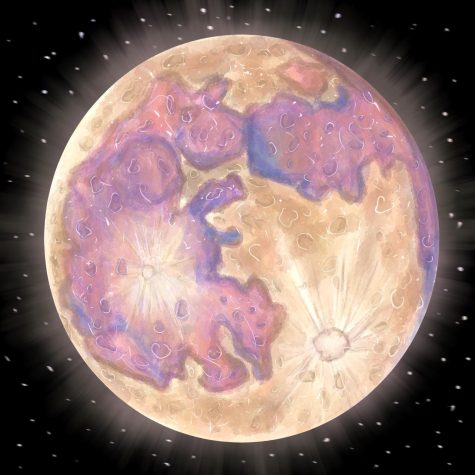Approaching the end of the world in ‘Sea of Tranquility’
Emily St. John Mandel’s latest novel deconstructs the art of traveling through time, space and love.
In the new wave of an interest in introspective fiction that has swept the generation, a direct result of a newfound enthusiasm toward literature thanks to social media platforms such as TikTok and Twitter — think “The Secret History” by Donna Tartt and “Normal People” by Sally Rooney — one novel stands out, particularly due to its masterful use of literary elements and simple plot structure in the otherwise typically technical genre of science fiction. Though the genre remains primarily characterized by novels such as Shelley’s “Frankenstein” and Wells’s “The Time Machine,” both of which are notable for their formal and elevated approaches to diction while maintaining a heavy emphasis on literal science, “Sea of Tranquility” by Emily St. John Mandel applies a vastly different perspective to sci-fi that eulogizes the value of living with simplicity while still honoring its predecessors.
With lyrical prose and characters developed with all the tangibility of one of J. D. Salinger’s himself, “Sea of Tranquility” offers one viewpoint into the longstanding “Are we living in a simulation?” hypothesis while maintaining the humanness and character likeability that underlies many of 2022’s most popular novels. Mandel’s latest piece of speculative fiction does so primarily through a series of slice-of-life type examinations and a circular narrative form of various characters’ lifespans in order to give the reader a picture of how seemingly unrelated parts of a story can all come together in a cohesive whole.
The story structure of “Sea of Tranquility” is primarily characterized by what is informally referred to as “Chekhov’s Gun” — the literary principle coined for the inventor and culturally significant Russian author Anton Chekhov, in which every even vaguely mentioned element of a story circles back to the plot — however, it is not this, nor the circular narrative, nor the homeostasis masterfully maintained between each of the plot lines, but rather the humanity distinct in the novel’s primary narrators and emphasized through the prose which is so appealing and undeniably responsible for the vast success of the novel.
“Sea of Tranquility” opens with exiled eighteen-year-old Edwin St. John St. Andrew, a former member of a wealthy family, leaving his homeland of England to an island “more or less at the halfway point between England and Canada” in the year 1912. Though his situation is certainly idiosyncratic — very few can claim to have been exiled from their families’ estates for holding humanist views considered radical in early 20th century England — there are elements of it that are intended to allow the reader to find comfort in relatability, particularly the feeling of isolation from one’s peers or family caused by holding unpopular beliefs and the dizziness of being presented with a blank canvas to life.
Despite Edwin’s jarring situation, his main concern is not attempting to regain his standing with his family, as one may assume, but rather to enjoy the recklessness of being able to abandon his old, constraining lifestyle, however physically comfortable, in favor of one that affords more freedom and genuine enjoyment of life. And enjoyment Edwin finds: quickly settling into lodging on a new location, revealed to be Halifax, a town on the eastern coast of Canada, he finds that he has much more time for leisure, engaging in simple and fulfilling activities such as sketching still life, taking walks down to the harbor and browsing markets, “buying things that he doesn’t especially need: a loaf of bread, a postcard or two, a bouquet of flowers.” The simplicity of aloneness as a reprieve is further solidified as one of the novel’s themes when Edwin realizes that “a life of solitude could be a very pleasant thing,” and especially so when juxtaposed with his moving to the fictitious village of Caiette, Canada, after he is whisked away there by another traveler.
Several weeks into Edwin’s life on Caiette, the central plot device of the book — time travel — is first hinted at.
One day while exploring the island, Edwin suddenly experiences a combination of nausea, blackout and the effect of a thousand memories at once. Moments after the experience he encounters a priest, who provides his name as Father Roberts, who, despite his kindness to Edwin, causes him to feel an unsettling amount of unease and uncertainty.
After Edwin’s strange encounter, the timeline switches to 2020, to the point-of-view of a young woman named Mirella Kessler, who attends a concert held by famous composer Paul Smith in hopes of reconnecting with his sister Vincent, a long lost friend of hers. After losing contact with her friend, she hopes to find answers through Paul, but is soon informed by him that she has passed several years after experiencing an odd blackout.
Fast forward a couple hundred years both literally and in terms of technological advancement to 2203 — settlers have now moved to the moon — and the storyline now pans to a character named Olive Llewellyn, a famous writer who is doing a book tour on Earth.

Back on the moon, an interglobal, lethal pandemic is brewing unbeknownst to Olive who too experienced a blackout similar to that of Edwin. On her book tour for her novel “Marienbad,” which is taking place on Earth, one interviewer, by the name of Gaspery-Jacques Roberts, who happens to share the same name as one of the characters in “Marienbad,” shifts his focus from her experience writing novels instead of asking about the blackout. The experience leaves Olive thoroughly disoriented and she soon realizes that there is very little she can do to save her family from the pandemic except hope.
These three stories, appearing entirely unrelated save for the single flash of darkness thinly weaving them together, are explored in a fourth character’s storyline — only hinted at through the previous timelines yet contains the answers for the anomalies — which ties the novel’s loose ends together in a clean and satisfying knot.
Mandel’s ability to create atmosphere while establishing themes and multiple distinct narrators in such few words is truly remarkable. In only 255 pages, Mandel establishes four distinctive characters with recognizable dialogue and behavior patterns and multiple well-thought-out, vivid settings.
However, the magic of the novel lies not in the intricate way Mandel weaves together the cast’s storylines, nor her worldbuilding ability, but rather in the way that she balances the beautiful poignancy of tragedy with the ever-present human desperation for simplicity and love. Applicable especially during a pandemic — in which isolation is characteristic — one may call it a very Homeric sentiment, but the looming, very tangible possibility of an unhappy end amplifies the already limited number of minutes that humans have to spend with each other, throwing them into technicolor and asking us to make the decisions that will allow our futures to prosper, or the ones that will make our current moments as vivid as possible. And, pandemic or not, should the fact that our years are numbered not influence the way we live our lives?
Though the reception to “Sea of Tranquility” has been extremely favorable, the novel is not without its critics. Though the simplicity of the novel is undeniably one of the characteristics that makes it so appealing to its fans, others find Mandel’s attempts to answer existential philosophical questions superficial, believing them to be uncomplex.
“. . . I found Mandel’s attempts to address . . . questions [regarding human nature] to be lackluster and overly simplistic,” claims one critic, Lily Zhou of the Stanford Daily. “I’m left unconvinced, ultimately, of whether this novel needs or deserves a neat, easy resolution at all.”
One must acknowledge that Zhou’s admittedly justified claim of philosophical oversimplicity is a tradeoff for the benefit of accessibility that is offered. By addressing existentialist fiction — a topic generally considered to be conquered by philosophical litterateurs such as the highly ruminative yet confessedly academic classisists Camus, Sartre and Nietzsche — in a significantly more readable manner, Mandel subliminally introduces philosophical concepts to an audience comprised primarily of young adults unlikely to be familiar with such a background. However, such accessibility forces Mandel to somewhat surrender the inherent complexity of existentialism, causing certain aspects of the novel to appear “watered-down” — for instance, one may point out that the “neat, easy resolution” takes away from the characters’ abilities to fully internalize their questions or answers as they are sacrificed in favor of a happy ending.
All things considered, “Sea of Tranquility” is undeniably an extremely thoughtful piece of speculative fiction that skillfully manipulates the complex acts of worldbuilding and exploring fictional relationships in a context so applicable to the real world in the time of the novel’s authorship. Though the novel has its flaws in addressing the philosophical questions that underlay its theme of existentialism, it must be acknowledged that Mandel does an excellent job in upholding many of the traditionally important elements of a story, and especially so plot, characters, and setting.
“Sea of Tranquility” is published by Knopf (USA) and Pan Macmillian (UK) and is available in paperback, hardcover and ebook formats. It can be purchased on Amazon or from other retailers.
Your donation will support the student journalists of Salem High School - MI. Your contribution will allow us to purchase equipment and cover our annual website hosting costs.

Nidhi Kundargi is currently a senior at Plymouth High School who joined The Perspective in fall 2022. She is the President of the Model United Nations...

Arya Sharma is an International Baccalaureate senior at Salem High School. He was introduced to The Perspective during summer 2022 through RJ Doroshewitz,...









